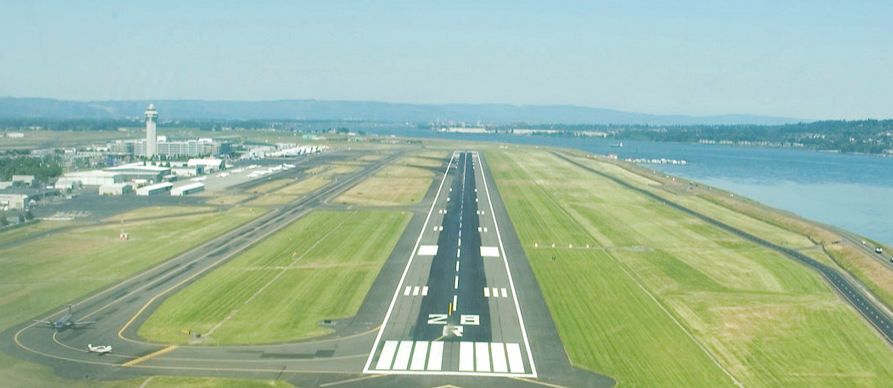
A stabilized approach is one in which the pilot establishes and maintains a constant angle glide path towards a predetermined point on the landing runway.
It is based on the pilot’s judgment of certain visual clues and depends on the maintenance of a constant final descent airspeed and configuration.
Under most circumstances, the airplane should be:
- Stabilized by 1,000 feet above airport elevation in instrument meteorological conditions (IMC)
- Stabilized by 500 feet above airport elevation during straight-in approaches in visual meteorological conditions (VMC).
Seven major elements of a stabilized approach
Pilots should monitor at least seven major elements (with only minor deviations: ) that define a stabilized approach in a GA airplane.
2.1.4.1 Glidepath. The airplane is on the correct flightpath. Typically, the glidepath is 3°, (not all visual guidance is 3°) to the runway touchdown zone (TDZ) (obstructions permitting).
What is a 3 degree glidepath? if you multiply the distance to go (in feet) by the tangent of 3 degrees you get the height at that point (in feet). For a 3 degree glide path that comes to 318 feet every nautical mile. Or you can round that to 320 feet per nautical mile, or even 300 feet per nautical mile.
2.1.4.2 Heading. The airplane is tracking the extended centerline to the runway with only minor heading/pitch changes necessary to correct for wind or turbulence to maintain alignment. Bank angle should not exceed 15 degrees on final approach.
2.1.4.3 Airspeed. The pilot maintains a constant target airspeed within +10/-5 knots indicated airspeed (KIAS), which is usually at, but no lower than, the recommended landing speed specified in the pilot’s operating handbook (POH)/Airplane Flight Manual (AFM), approved placards/markings, or 1.3 times the stall speed or minimum steady flight speed at which the airplane is controllable in the landing configuration (VSO), if not specified.
Note: Most small airplanes maintain a speed well in excess of 1.3 times VSO on an instrument approach (pilot’s discretion). An airplane with a VSO of 50 knots has a normal approach speed of 65 knots. However, this same airplane may maintain 90 knots (1.8 VSO) while on the final segment of an instrument approach.
Pilots generally select an appropriate approach speed for the prevailing weather, aircraft, traffic, and performance conditions, but not less than 1.3 VSO. However, aircraft are usually slowed to a normal landing speed when on the final approach just prior to landing.
2.1.4.4 Configuration. The airplane is in the correct landing configuration with flaps as required, landing gear extended, and the airplane in trim.
2.1.4.5 Rate of Descent. Descent rate is a constant and generally no greater than 500 feet per minute (fpm). If a descent greater than 500 fpm is required due to approach considerations, it should be reduced prior to 300 feet above ground level (AGL) and well before the landing flare and touchdown phase. Note: FAA also state that pilots should not exceed 1,000 fpm, but may if they can correct in a timely manner.
2.1.4.6 Power Setting. Power setting is appropriate for the airplane configuration and is not below the minimum power for approach as defined by the POH/AFM.
2.1.4.7 Checklists / Briefings. All briefings and checklists (except the landing checklist) are completed prior to initiating the approach. Note: For a typical GA piston airplane in a traffic pattern, if the approach becomes un-stabilized below 300 feet AGL, the pilot should initiate an immediate go-around.
Using a stabilized approach concept in the traffic pattern
- Be aggressive about making bigger changes very early to get on course, speed, and glidepath so that you only need small changes later
- Start your descent on downwind or base leg when you can make a continuous descent on an approximate 3° glide path with minor adjustments
- 3° is about 300 feet of altitude per nautical mile
- From 1,000 feet AGL, you would start your descent with just over 3 miles of ground track remaining to the runway
- A descent rate in feet per minute of approximately 5 times your groundspeed will give you a 3-degree glide path
- At 60 knots groundspeed, your descent rate should be about 300 FPM
- 3° is about 300 feet of altitude per nautical mile
- Use a controlled and stabilized pitch attitude, with minor pitch and power adjustments, to maintain the target descent rate
- Porpoising and significant power changes are indications that the approach is not stabilized
- Gradually increase flaps so as to be in the landing configuration on final
- Maintain an indicated airspeed of approximately 1.3 times stalling speed in the current configuration and at the current weight
- If it is different, use the recommended landing speed specified in the pilot’s operating handbook or on approved placards/markings
- For an airplane that stalls in the current configuration at 40 knots, the approach speed would be 52 knots
- Make smooth and minor power adjustments to maintain target speeds and descent rates
- Maintain a deliberate and steady ground track with heading adjustments as necessary to correct for the wind
- If major corrections are required when less than 300 feet AGL, use the opportunity to practice a smooth and controlled go-around